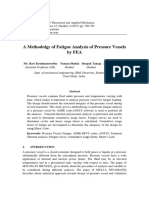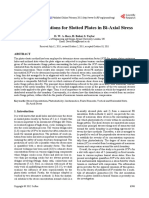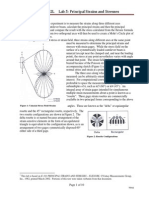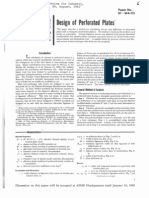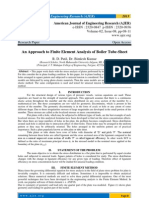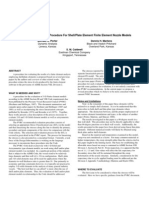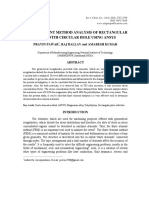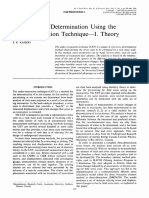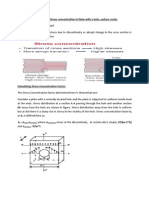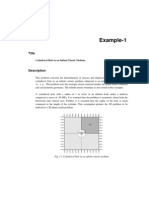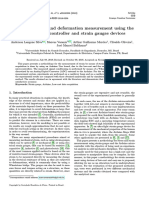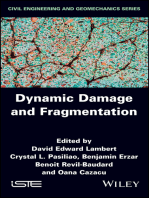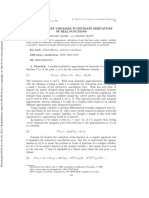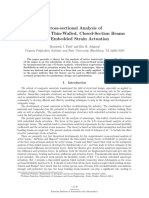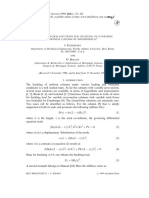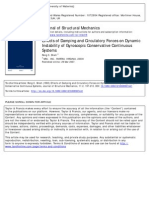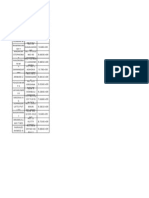Circular Plate Ribbed 1
Circular Plate Ribbed 1
Uploaded by
Ascanio BarbosaCopyright:
Available Formats
Circular Plate Ribbed 1
Circular Plate Ribbed 1
Uploaded by
Ascanio BarbosaOriginal Description:
Copyright
Available Formats
Share this document
Did you find this document useful?
Is this content inappropriate?
Copyright:
Available Formats
Circular Plate Ribbed 1
Circular Plate Ribbed 1
Uploaded by
Ascanio BarbosaCopyright:
Available Formats
Proceedings in Manufacturing Systems, Volume 8, Issue 1, 2013
ISSN 2067-9238
STRESS STATES IN PLANE AND RIBBED CIRCULAR PLATES
Carmen T. POPA1,*, Radu I. IATAN2, Ciprian I. MANESCU3
1)
Lecturer, PhD, eng., Department of Food Engineering, University Valahia, Targoviste, Romania
2)
Prof., PhD, eng., eng., University Politehnica, Bucharest, Romania
3)
Assist., PhD, eng., Inventiv SRL, Ploiesti, Romania
Abstract: Circular or annular plates and mostly ribbed structures have multiple utilizations in numerous
engineering domains: processing equipments, naval, metallurgy, civil constructions industries. The engineering ability, implemented in practice, introduced to reduce the consuming of materials, but also the
energy consuming, alternative solutions: materials for replacement or rigidifying using ribs. The topic of
this paper takes into discussion the particular case of the structures with constructive orthotropy.
In this paper is presented the analysis of stresses states for a plane and for a ribbed plate, to observe the
advantage of the rigidifying. The presence of the ribs leads to reduce the consuming of metallic material.
The plates, of the same dimensions, are solicited at 0.3 MPa pressure. For comparison, we used the analytical, finite elements and experimental methods for the plane plate and for the ribbed plate, we used the
finite elements and experimental methods. In the technical literature, for the ribbed plate there is an analytical method for calculating of the deformation and stresses states, only some approximations for particular cases. Finally, as we infer from the comparison of the results, we observe the advantage of the rigidity of the plate. In this case the value of the stresses lower about three times. Closed values are obtained using the variants of calculus: analytical, finite elements and experimental. However, we note that
at the embedded plates the maximum of stresses is located on the contour.
Key words: plane circular plate, circular plate with ribs, stresses states, numerical method, experimental
method, analytical method.
1. INTRODUCTION
The engineering ability, implemented in practice, introduced to reduce the consuming of materials, but also
the energy consuming, alternative solutions: materials for
replacement or rigidifying using ribs. The topic of this
paper takes into discussion the particular case of the
structures with constructive orthotropy.
Circular or annular plates [1], of constant or variable
thickness, connected with rigidity elements-by casting,
bonding or welding, are met in numerous engineering
domains [2 and 3]. Radial and/or annular ribs can be
disposed symmetrical or not, toward the middle surface
of the proper plate.
The searches had been done to establish the displacements and stresses states at plates rigidified with
ribs can be grouped in:
a) Approximate calculus methods of the stresses and
displacements states;
b) Methods which abase the study at behaviour of the
compound elements: plates and ribs, that are considered with different leaning ways;
c) Calculus methods that abase the structural orthotropic
at material orthotropic;
*
Corresponding author: University Valahia from Targoviste,
Tel.: 0744310647;
Fax: 035109907;
E-mail addresses: carmenpopa2001l@yahoo.com (C. Popa),
r_iatan@ yahoo.com (R. Iatan), cpmanescu@yahoo.com (C.
Manescu)
d) Numerical methods [49];
e) Experimental methods [10].
In this paper the following aspects are realized:
the determination of the stresses states for a plane
plate, using the methods: analytical, finite elements
and experimental;
determination of the stresses states for a plane plate,
using the methods: analytical, finite elements and experimental; the determination of the stresses states for
a ribbed plate, using the methods: finite elements and
experimental. The analytical method for the ribbed
plate was analyzed in the scientific publication only
for some particular cases;
comparison of the obtained values.
2. PLANE PLATE ANALYZE
2.1. Elements finite method
We analyze the plane plate, having 32 holes, and
geometrical characteristics from Fig. 1, using finite element method. We consider that the plate is fixed on circumference of the holes for the screws, which clamp this
plate by the experimental recipient [13]. Using the program, the plate was divided in mesh-type tetrahedron
elements. The plane plate with 32 holes were divided in a
total of 16 696 elements and 5 561 nodes. We present the
calculus variant with finite elements, the plate stresses
distribution at 0.3 MPa being presented in Fig. 2.
Stresses from Fig. 3 are obtained at pressure of 0.3 MPa,
C. Popa, R. Iatan and C. Mnescu / Proceedings in Manufacturing Systems, Vol. 8, Iss. 1, 2013 / 5358
54
Fig. 2. Stresses of the fixed plane plate, at pressure 0.3 MPa.
( IV ) =
2r + 2 r .
(3)
Fig. 1. Geometrical characteristics of the circular plane plate.
The radial and circumferential stresses at a certain radius are established with the relations:
using a plan which passes through the centres of two
exactly contrary holes, which are situated between two
neighbour holes. Stresses values are given in Table 1.
6
6
M r ; = 2 M .
2
The expressions of the bending moments are:
p
M r = (1, 3 r c2 r 3 , 3 r 2 ) ;
16
r=
2.2. Analytical method
In this case the plane plate is considered fixed on the
line of the centres of the holes, at rcr= 285 mm.
We use the relations (1, 2, and 3) for the evaluation of
stresses on the circumference of leaning [11]:
r = 0 , 225
= 0 , 75
pr
2
cr
2
pr
(1)
stresses at median surface of the plate; p uniform
2
cr
distributed pressure on the surface of the plate; rcr radius of the embedded circumference of the plate;
(2)
Table 1
Stresses [N/mm2], at 0.3 MPa pressure, for the fixed plane plate
r [mm]
[N/mm2]
(5)
p
(6)
(1, 3 r c2 r 1, 9 r 2 ) .
16
where: r , , e are radial, circumferential, equivalent
M
(4)
21
36
50
66
80
95
110
124
138
152
167
129.8
129.7
128.3
125.4
120.9
113.5
108.1
99.88
91.58
81.19
72.56
62.68
59.79
178
194
211
225
239
251
262
273
285
57.99
62.67
76.43
95.4
113.2
127.3
159.3
244.4
44.31
Fig. 3. Stresses of the fixed plane plate, at 0.3 MPa pressure.
C. Popa, R. Iatan and C. Mnescu / Proceedings in Manufacturing Systems, Vol. 8, Iss. 1, 2013 / 5358
Table 2
Stresses [N/mm2], at 0.3 MPa pressure, for the fixed
plane plate, using finite elements and analytical methods
23
Finite elements
method
95.4
225
Analytical method
75
11 9
thickness of the plate; M r , M radial bending
moment (acting in a diametral plane of the plane circular
plate), respectively annular bending moment; r current
radius.
The value of equivalent stress on the leaning contour
of the plate is m a x 2 = 162 . 4 N/mm2, for the pressure of
0.3 MPa. The equivalent stress at radius r = 225 mm
(because at radius rcr = 285 mm in MEF large increases
of the stress are recorded) is
= 75 N/mm2.
As seen from Table 2, where the maximum values of
stresses established by the two methods for calculating
are processed, the values of stresses fond by finite element method are relatively close to those found by analytical method. In the case of finite element analysis, the
plate had been fixed on the internal contour of the holes,
and in the case of analytical method, the plate had been
fixed in the continuous outline generated of the centre
holes.
If it is supposed at a value of the pressure of 0.3 MPa,
we obtain the maximal value of stress on the fixed line,
like in Table 2.
2.3. Experimental method
In the experimental case, we take into account the
measuring of specific linear deformations of the external
points of the plate and calculus of the radial, circumferential and equivalent stresses, in the same conditions,
using the strain gauges [5].
The components of the experimental stall are presented in Fig. 4, where: 1 vessel with the plates for
testing; 2 manometer; 3 branch; 4 tap (open during
the filling with water of the tap and closed during pressing); 5 bend; 6 pump group; 7 funnel for the filling
of the installation.
4 3
24
22
21
20
19
[N/mm ]
r[mm]
55
12 10 8
26
25
4
3
6
5
100
13
15
17
14
150
16
18
200
Fig. 5. The position of the strain gauges on the plane plate.
To assess the stresses developed both on the upper
surface of plane plate and on the plate with radial ribs,
under the action of the pressure created inside the experimental vessel, two perpendicular directions were
accepted to be provided in the cross transducers, numbered with odd numbers (those in the direction radial)
and with even numbers (transducers oriented in circumferential direction).
The zones where the strain gauges are fixed on the
plate are presented in Fig. 5. The used strain gauges are
KM120, with R = 120 resistance and K = 2.04 2 %
elastic constant.
We measured the radial and circumferential deformations values, both at the increase and decrease of the
pressure, obtaining the values: 0.05; 0.1; 0.15; 0.2;
0.
25; 0.3 MPa. We had been realized the processing of the
experimental data using mathematical program, accepting a linear variation, which depends on parameter pressure. We obtained the equivalent stresses values, which
are represented in the Table 3, using the fourth resistance
criterion. On their basis, the diagram in Fig. 6 was obtained.
Used to calculate the radial, annular and equivalent
stresses are the relations:
Fig. 4. Schema of the experimental stall.
Fig. 6. The variation of the equivalent stresses which are calculated on the basis of the fourth resistance theory.
C. Popa, R. Iatan and C. Mnescu / Proceedings in Manufacturing Systems, Vol. 8, Iss. 1, 2013 / 5358
56
r =
1
E
( r + p ) ;
p
2
p
p [MPa]
( + p r ) ;
1 2p
( IV ) =
Table 3
The values of the equivalent stresses at 0.3 MPa
(7)
e [ N mm 2 ]
r [mm]
MA
MEF
ME
118v8
130.1
121.3
125
76.1
83.8
77.2
175
51.0
66.7
58.2
225
75.0
74.4
70.7
(8)
r2 + 2 r .
(9)
0.3
Obs.
e ( IV)
e ( IV)
e ( IV)
e ( IV)
Fig. 7. Geometrical characteristics of the circular ribbed plate.
Fig. 8. Stresses of the fixed ribbed plate, at 0.3 MPa pressure.
Table 4
Stresses [N/mm2], at 0.3 MPa pressure, for the fixed plate with ribs
r [mm]
p=
0.3MPa
0
36.92
7
36.44
21
35.6
36
32.89
50
28.14
66
23.85
80
41.5
95
40.38
110
31.28
124
30.11
138
31.05
178
194
211
225
239
251
262
273
285
25.71
17.73
13.75
29.82
45.91
62.24
94.75
129.6
40.71
152
30.66
167
27.72
C. Popa, R. Iatan and C. Mnescu / Proceedings in Manufacturing Systems, Vol. 8, Iss. 1, 2013 / 5358
57
Fig. 9. Stresses of the fixed ribbed plate, at 0.3 MPa pressure.
3. RIBBED PLATE ANALYZE
ME
3.1. Elements finite method
We analyze the ribbed plate, having 32 holes, and
geometrical characteristics from Fig. 7, using finite element method. We consider that the plate is fixed on circumference of the holes for the screws, like in the case of
the plane plate [13]. Also, we present the calculus variant
with finite elements. The plate stresses distribution, at 0.3
MPa pressure is presented in Fig. 8.
Stresses from Fig. 9 are obtained at pressure 0.3 MPa,
using a plan, which passes through the centres of two
exactly contrary holes, which are situated between two
neighbour holes. Stresses values are given in Table 4.
3.2. Experimental method
In the experimental case, we take into account the
measuring of specific linear deformations of the external
points of the plate and calculus of the radial, circumferential and equivalent stresses, in the same conditions,
like in the case of the plane plate, using the strain gauges
[13].
The zones where the strain gauges are fixed on the
plate are presented in Fig. 10. We also used the strain
gauges.
MEF
Fig. 11. The variation of the equivalent stresses which are
calculated on the basis of the fourth resistance theory.
Table 5
The values of the equivalent stresses, which are
theoretical and experimental calculated (MA), (MEF) and
(ME), at 0.3 MPa pressure, for the ribbed plate
p
[MPa]
24
22 23
20 21
0.3
r
[m
m]
e [ N mm 2 ]
MA
MEF
ME
36.92
39.20
125
31.9
3,4
175
25.9
27.60
225
58.1
57,7
19
11 9 7
12 10
26
25
5
100
13
14 15
16
17
18
e ( IV )
e ( IV )
e ( IV )
e ( IV )
4
3
Obs.
150
We obtained the equivalent stresses values, which are
represented in the Table 5, using the fourth resistance
criterion. Figure 11 derived from these results.
4. CONCLUSIONS
200
Fig. 10. The position of the strain gauges on the ribbed plate.
We take into account the deformations, respectively
stresses values, which are produced in different points of
the plate. As we infer from the comparison of the results,
we observe the advantage of the rigidity of the plate. In
58
C. Popa, R. Iatan and C. Mnescu / Proceedings in Manufacturing Systems, Vol. 8, Iss. 1, 2013 / 5358
this case the value of the stresses lower about three times.
Closed values are obtained using the variants of calculus:
analytical, finite elements and experimental. However,
we note that at the embedded plates the maximum of
stresses is located on the contour.
REFERENCES
[1] R.T. Iatan, C. Popa, Thermal stress in monolayer plane
and circular plates variable temperature in the direction
of radius, Revista de Chimie, Vol. 60, Iss. 5, 2009, pp.
513517.
[2] V.V. Jinescu, Utilaj tehnologic pentru industrii de proces
(Technological equipment for process industries), Edit.
Tehnic, Bucharest, 1983, pp. 14.
[3] A.l. Pavel, Elemente de inginerie mecanic (Mechanical
engineering elements), Edit. Didactic i Pedagogic, Bucharest, 1981.
[4] M.H. Kargarnovin, S.A. Faghidian, Y. Farjami, G.H.
Farrahi, Application of homotopy-Pad technique in limit
analysis of circular plates under arbitrary rotational
symmetric loading using von-Mises yield criterion, Communications in Nonlinear Science and Numerical Simulation, Vol.15, Iss. 4, 2010, pp. 10801091.
[5] E. Melerski, Circular plate analysis by finite differences.
Energy approach, Journal of Engineering Mechanics, 115
(6), 1989, pp. 12051224.
[6] M. Kadkhodayan, An investigation to the orthotropic
plates by using irregular rectilinear mesh, Proceedings of
the IASTED International Conference on Modelling, Identification, and Control, MIC, 2007, pp. 259264.
[7] M. Marek, M. Krzysztof, Optimal design of sandwich
ribbed flat baffle plates of a circular cylindrical tank,
International Journal of Pressure Vessels and Piping, Vol.
82, Iss. 3, March 2005, pp. 227233.
[8] N.J.H. Holroyd, J. Carrigan, W. Hepples, Y. Gao, Design
optimization of flat-bottomed high pressure gas cylinders,
Proceedings of the ninth international conference on pressure vessel technology, Sydney, 2000, pp. 841.
[9] O. Zienkiewicz, The finite element method, Vol. 12, Mc
Graw-Hill, London, 1991.
[10] C. Popa, Cercetri privind solicitrile plcilor plane
circulare rididizate cu nervuri radiale cu geometrie variabil (Researches regarding circular plane plate loading
reinforced by radial ribs with variable geometry), PhD thesis, Bucharest, 2006.
[11] G. Buzdugan, Rezistena materialelor (Strength of materials), Edit. Tehnic, Bucharest, 1980.
[12] M. Cheung, L. Wenchang, Finite strip method combined
with other numerical methods for the analysis of plates,
Computers and structures, Vol. 45, No. I, 1992, pp. 7985.
[13] W.A. Henry, Elements of experimental stress analysis,
Pergamon Press, London, 1977.
[14] S.P. Theocaris, Experimental stress analysis, Technical
Press, Bucharest, 1977.
You might also like
- Novozhilov Yappa Electrodynamics PDFDocument362 pagesNovozhilov Yappa Electrodynamics PDFAscanio Barbosa100% (1)
- Address Name A/C Type A/C No: Southeast Bank Limited Rupdia Bazar Branch Statement of AccountsDocument1 pageAddress Name A/C Type A/C No: Southeast Bank Limited Rupdia Bazar Branch Statement of Accountsgreen xmNo ratings yet
- Key Factors Contributing Wal-Mart's SuccessDocument3 pagesKey Factors Contributing Wal-Mart's SuccesswasmosyNo ratings yet
- Membrane StressesDocument6 pagesMembrane StressesAyesha JavaidNo ratings yet
- Nitin Eng Journal PDFDocument16 pagesNitin Eng Journal PDFpdhurveyNo ratings yet
- 152 1199 2 PB PDFDocument16 pages152 1199 2 PB PDFRohit GadekarNo ratings yet
- Nitin Eng Journal PDFDocument16 pagesNitin Eng Journal PDFpdhurveyNo ratings yet
- Parametric Study of Flexibility Factor For Curved Pipe and Welding ElbowsDocument9 pagesParametric Study of Flexibility Factor For Curved Pipe and Welding Elbowsbam_1962No ratings yet
- A Methodolgy of Fatigue AnalysisDocument16 pagesA Methodolgy of Fatigue AnalysisajkNo ratings yet
- Isotropic Linear Elastic Stress ConcentrationDocument19 pagesIsotropic Linear Elastic Stress ConcentrationIoan-Lucian StanNo ratings yet
- 2017 (F) MS Med 4Document6 pages2017 (F) MS Med 4muhammad azharNo ratings yet
- Stress Concentrations For Slotted Plates in Bi-Axial Stress: D. W. A. Rees, H. Bahai, S. TaylorDocument7 pagesStress Concentrations For Slotted Plates in Bi-Axial Stress: D. W. A. Rees, H. Bahai, S. TaylorYasser BahaaNo ratings yet
- "Analysis of A Rectangular Plate With A Circular Hole": Term Paper OnDocument12 pages"Analysis of A Rectangular Plate With A Circular Hole": Term Paper OnPiyush GuptaNo ratings yet
- ASME PaperDocument17 pagesASME PaperChristopher BrownNo ratings yet
- ISTAM - Stress Concentration Factor Convergence Study of A Thin PlateDocument7 pagesISTAM - Stress Concentration Factor Convergence Study of A Thin PlateKanak_KalitaNo ratings yet
- SCF in Isotopic & Orthotropic Plates Part I: Uniaxial LoadDocument7 pagesSCF in Isotopic & Orthotropic Plates Part I: Uniaxial LoadNandit JadvaniNo ratings yet
- Fatigue Analysis ThesisDocument17 pagesFatigue Analysis ThesisIdris SiddiquiNo ratings yet
- Determination of Stress Concentration FactorsDocument5 pagesDetermination of Stress Concentration FactorsEduardo Felippe de SouzaNo ratings yet
- Me 42 PDFDocument5 pagesMe 42 PDFMohamed Rafeek0% (1)
- Assembly Stress For The Reduction of Stress ConcentrationDocument9 pagesAssembly Stress For The Reduction of Stress Concentrationkhudhayer1970No ratings yet
- Cosmos Design Star Study - The Tensile Test of The Rectangular PlateDocument12 pagesCosmos Design Star Study - The Tensile Test of The Rectangular PlateapsarasoNo ratings yet
- Lab 5Document10 pagesLab 5Tayyab ZafarNo ratings yet
- Design of Perforated PlatesDocument13 pagesDesign of Perforated PlatesScribdUserBest100% (1)
- Prensa BriquetasDocument8 pagesPrensa BriquetasMatiasMorzilliNo ratings yet
- Residual Stresses in Iron: CastingsDocument37 pagesResidual Stresses in Iron: CastingsAdityaNo ratings yet
- An Approach To Finite Element Analysis of Boiler Tube-SheetDocument4 pagesAn Approach To Finite Element Analysis of Boiler Tube-SheetAJER JOURNALNo ratings yet
- Nozzle Stress ClassificationDocument6 pagesNozzle Stress ClassificationHitesh SuvarnaNo ratings yet
- Bending and Axial Compression With RestraintsDocument8 pagesBending and Axial Compression With RestraintsszalaijaNo ratings yet
- Ligament Pressure Vessel AnalysisDocument8 pagesLigament Pressure Vessel AnalysisAnnie HillNo ratings yet
- Limit Load SolutionsDocument131 pagesLimit Load SolutionsZaid KamardinNo ratings yet
- Finite Element Method Analysis of Rectangular Plate With Circular Hole Using Ansys PDFDocument12 pagesFinite Element Method Analysis of Rectangular Plate With Circular Hole Using Ansys PDFVikashNo ratings yet
- Finite Element Method Analysis of Rectangular Plate With Circular Hole Using AnsysDocument12 pagesFinite Element Method Analysis of Rectangular Plate With Circular Hole Using AnsysNarayana Swamy GNo ratings yet
- Zeng 1990Document10 pagesZeng 1990obaidullah.dsuNo ratings yet
- Engineering Mechanics 2012: Determination of Burst Pressure of Thin-Walled Pressure VesselsDocument11 pagesEngineering Mechanics 2012: Determination of Burst Pressure of Thin-Walled Pressure VesselspajadhavNo ratings yet
- 3144Document10 pages3144Mona AwadNo ratings yet
- Stress Analysis of Cutout PlateDocument6 pagesStress Analysis of Cutout PlateKanak_KalitaNo ratings yet
- Stress Concentrations For Straight-Shank and Countersunk Holes in Plates Subjected To Tension, Bending, and Pin LoadingDocument19 pagesStress Concentrations For Straight-Shank and Countersunk Holes in Plates Subjected To Tension, Bending, and Pin LoadingJacob VergheseNo ratings yet
- Analysis of A Plate With A Circular Hole by Fem: January 2013Document7 pagesAnalysis of A Plate With A Circular Hole by Fem: January 2013kr0999351No ratings yet
- Wiles1994 - in Situ Stress Determination Using The Under-Excavation Technique - I. TheoryDocument8 pagesWiles1994 - in Situ Stress Determination Using The Under-Excavation Technique - I. TheoryRisantoNo ratings yet
- Neutrally Reinforced Holes in Symmetrically Laminated PlatesDocument3 pagesNeutrally Reinforced Holes in Symmetrically Laminated Plateskhudhayer1970No ratings yet
- Title-Stress Concentration in Plate With A Hole, Surface Cracks What Is Stress Concentration?Document4 pagesTitle-Stress Concentration in Plate With A Hole, Surface Cracks What Is Stress Concentration?anubhavjoatNo ratings yet
- 01 GeoStrucAnal Cylinder Elastic PDFDocument12 pages01 GeoStrucAnal Cylinder Elastic PDFSiddhant KaushikNo ratings yet
- Fatigue Critical Plane According To Variance and Cumulative Damage Methods Under Multiaxial LoadingDocument12 pagesFatigue Critical Plane According To Variance and Cumulative Damage Methods Under Multiaxial LoadingAdemar CardosoNo ratings yet
- MAE 212: Spring 2001 Module III: Material Property Characterization Using Strain Gage InstrumentationDocument7 pagesMAE 212: Spring 2001 Module III: Material Property Characterization Using Strain Gage InstrumentationChulbul PandeyNo ratings yet
- Laboratory Rock Mechanics: MNG 551-001 Laboratory #6 Elastic Moduli and Constants ASTM D4543 &7012Document7 pagesLaboratory Rock Mechanics: MNG 551-001 Laboratory #6 Elastic Moduli and Constants ASTM D4543 &7012PhilipeInneccoNo ratings yet
- Pvp1998-Vol368 1Document5 pagesPvp1998-Vol368 1Nisarg PatelNo ratings yet
- Hydrostatic Effects in Tubular Member DesignDocument6 pagesHydrostatic Effects in Tubular Member DesignrmahadevappaNo ratings yet
- Stress Paths Around Circular TunnelDocument7 pagesStress Paths Around Circular TunnelRay ChanNo ratings yet
- AIAA 98-2062 Analytical and Finite Element Modeling of Riveted Lap Joints in Aircraft StructureDocument11 pagesAIAA 98-2062 Analytical and Finite Element Modeling of Riveted Lap Joints in Aircraft StructureAgustinus DimasNo ratings yet
- Tension TestDocument7 pagesTension TestmanmathkNo ratings yet
- 1 s2.0 S0013794406004267 MainDocument11 pages1 s2.0 S0013794406004267 Mainzoranperovic3No ratings yet
- Urn NBN Si Doc 0e2ilttzDocument8 pagesUrn NBN Si Doc 0e2ilttzOscar CruzNo ratings yet
- Pub 1440Document8 pagesPub 1440kapilnandwanaNo ratings yet
- A Study of Strain and Deformation Measurement Using The Arduino Microcontroller and Strain Gauges DevicesDocument7 pagesA Study of Strain and Deformation Measurement Using The Arduino Microcontroller and Strain Gauges DevicesDavid VilcaNo ratings yet
- Analysis of Residual Stresses in Wire Drawing ProcessesDocument4 pagesAnalysis of Residual Stresses in Wire Drawing ProcessesRodrigo MedeirosNo ratings yet
- 124 TMT09 061Document4 pages124 TMT09 061vovancuong8No ratings yet
- Molecular Mechanisms in Materials: Insights from Atomistic Modeling and SimulationFrom EverandMolecular Mechanisms in Materials: Insights from Atomistic Modeling and SimulationNo ratings yet
- Dynamic Damage and FragmentationFrom EverandDynamic Damage and FragmentationDavid Edward LambertNo ratings yet
- Vector and Tensor Analysis. by H. V. Craig. ArtigoDocument4 pagesVector and Tensor Analysis. by H. V. Craig. ArtigoAscanio BarbosaNo ratings yet
- The HookeDocument1 pageThe HookeAscanio BarbosaNo ratings yet
- O Que Sao Os TensoresDocument32 pagesO Que Sao Os TensoresAscanio BarbosaNo ratings yet
- Weatherburn C.E.-Differential GeometryDocument6 pagesWeatherburn C.E.-Differential GeometryAscanio BarbosaNo ratings yet
- Composite Beam BoxDocument11 pagesComposite Beam BoxAscanio BarbosaNo ratings yet
- Complex Derivative To RealDocument3 pagesComplex Derivative To RealAscanio BarbosaNo ratings yet
- Prpriedades FisicasDocument22 pagesPrpriedades FisicasAscanio BarbosaNo ratings yet
- Variacional Coplex NNN4Document8 pagesVariacional Coplex NNN4Ascanio BarbosaNo ratings yet
- The Method of PfaffiansDocument6 pagesThe Method of PfaffiansAscanio BarbosaNo ratings yet
- (Mechanics of Elastic Stability 9) D. Bushnell (Auth.) - Computerized Buckling Analysis of Shells (1985, Springer Netherlands) PDFDocument438 pages(Mechanics of Elastic Stability 9) D. Bushnell (Auth.) - Computerized Buckling Analysis of Shells (1985, Springer Netherlands) PDFAscanio BarbosaNo ratings yet
- Rutura Madeira PDFDocument10 pagesRutura Madeira PDFAscanio BarbosaNo ratings yet
- Motion of A Rigid Body in Body-Fixed Coordinate System - An Example For Autoparrallel Trajectories in Spaces With TorsionDocument13 pagesMotion of A Rigid Body in Body-Fixed Coordinate System - An Example For Autoparrallel Trajectories in Spaces With TorsionAscanio BarbosaNo ratings yet
- Tubos Spirrally PDFDocument10 pagesTubos Spirrally PDFAscanio BarbosaNo ratings yet
- Estimation of Collapse Load For Thin-Walled Rectangular Tubes Under BendingDocument8 pagesEstimation of Collapse Load For Thin-Walled Rectangular Tubes Under BendingAscanio BarbosaNo ratings yet
- Cross-Sectional Analysis of Anisotropic, Thin-Walled, Closed-Section Beams With Embedded Strain ActuationDocument10 pagesCross-Sectional Analysis of Anisotropic, Thin-Walled, Closed-Section Beams With Embedded Strain ActuationAscanio BarbosaNo ratings yet
- Bending and Ovalization of Thin Walled Hollow Tubes Beyond Strength ofDocument8 pagesBending and Ovalization of Thin Walled Hollow Tubes Beyond Strength ofAscanio BarbosaNo ratings yet
- Euler's Critical LoadDocument4 pagesEuler's Critical LoadAscanio BarbosaNo ratings yet
- P OlverDocument7 pagesP OlverAscanio BarbosaNo ratings yet
- Structural Analysis of A Continuous BeamDocument5 pagesStructural Analysis of A Continuous BeamAscanio BarbosaNo ratings yet
- Solutions For Buckling of A Variable Stiffness Column by MathematicaDocument11 pagesSolutions For Buckling of A Variable Stiffness Column by MathematicaAscanio BarbosaNo ratings yet
- Conservation Laws For NonlinDocument10 pagesConservation Laws For NonlinAscanio BarbosaNo ratings yet
- 10 1016@j Jmps 2006 01 007 PDFDocument17 pages10 1016@j Jmps 2006 01 007 PDFAscanio BarbosaNo ratings yet
- Brezier EffectDocument22 pagesBrezier EffectAscanio BarbosaNo ratings yet
- Introduction of Concentrated Loads in Plates and ShellsDocument38 pagesIntroduction of Concentrated Loads in Plates and ShellsAscanio Barbosa100% (1)
- Effects of Damping and Circulatory Forcesof Gyroscopic ConservativeDocument18 pagesEffects of Damping and Circulatory Forcesof Gyroscopic ConservativeAscanio BarbosaNo ratings yet
- 131-2-25-05 Native ProcedureDocument21 pages131-2-25-05 Native ProcedurereachgscommNo ratings yet
- Mini Project Final DraftDocument29 pagesMini Project Final DraftAnimeshMukherkjeeNo ratings yet
- Mba III IV SemDocument119 pagesMba III IV SemKirtiNo ratings yet
- Research ProposalDocument9 pagesResearch Proposaljingky SallicopNo ratings yet
- SCRUM Guide November 2009Document21 pagesSCRUM Guide November 2009Perry van der SteenNo ratings yet
- Chapter5 SoilNailWalls 05042015Document25 pagesChapter5 SoilNailWalls 05042015Elhussain HassanNo ratings yet
- Nodal - Officers - Central Bank of IndiaDocument8 pagesNodal - Officers - Central Bank of IndiaMassy ZafarNo ratings yet
- Training and Development Department - Sanjana - KumariDocument3 pagesTraining and Development Department - Sanjana - KumarisanjanakumarisrccNo ratings yet
- Return Policy Enagic, USADocument1 pageReturn Policy Enagic, USADonalyn Calica SecuyaNo ratings yet
- The Cradle CrewDocument14 pagesThe Cradle Crewkrunkesh2020No ratings yet
- Montego Bay PergolaDocument36 pagesMontego Bay PergolaDavid PonceNo ratings yet
- Cypress Programmer User GuideDocument28 pagesCypress Programmer User GuideSamNo ratings yet
- Scmpe Compiler 4.0 - Ca Final - by Ca Ravi AgarwalDocument824 pagesScmpe Compiler 4.0 - Ca Final - by Ca Ravi Agarwalaella shivaniNo ratings yet
- Process ApproachDocument4 pagesProcess ApproachSuresh Gupta100% (1)
- Defining and Regulating Work Relations For The Future of WorkDocument36 pagesDefining and Regulating Work Relations For The Future of WorkMeita SelinaNo ratings yet
- Indian Debt MarketDocument32 pagesIndian Debt MarketProfessorAsim Kumar Mishra0% (1)
- Sample DatabaseDocument63 pagesSample DatabaseVijayan Madhavan PraveenNo ratings yet
- Design Reliability and MaintenabilityDocument4 pagesDesign Reliability and MaintenabilitymichealNo ratings yet
- Sw-584b Enp1 ManualDocument23 pagesSw-584b Enp1 ManualE SNo ratings yet
- Interview of A Teacher and School HeadDocument31 pagesInterview of A Teacher and School HeadNico PletaNo ratings yet
- Technical English 2020 Ch3Document6 pagesTechnical English 2020 Ch3Ahmed F. AlHallaqNo ratings yet
- FAOSTAT Data 3-12-2018Document66 pagesFAOSTAT Data 3-12-2018Valeria DumitrescuNo ratings yet
- Ecotoxicology Biocides PDFDocument425 pagesEcotoxicology Biocides PDFLia Gracy Rocha DinizNo ratings yet
- My Internship ReportDocument64 pagesMy Internship Reportmk6656556No ratings yet
- Letter of AcceptanceDocument6 pagesLetter of AcceptanceBhargavi RaoNo ratings yet
- Materi Training Defensive DrivingDocument17 pagesMateri Training Defensive DrivingEko Budi UtomoNo ratings yet
- Accounting Information Systems 1st Edition Richardson Test Bank 1Document65 pagesAccounting Information Systems 1st Edition Richardson Test Bank 1fannie100% (53)
- Lecture 1 - Foreign Exchange Markets and Exchange Rates IDocument15 pagesLecture 1 - Foreign Exchange Markets and Exchange Rates Ijtt123100% (2)









